PAPER SPLITTING: HISTORY AND MODERN TECHNOLOGY
IRENE BR�CKLE, & JANA DAMBROGIO
5 5. OBSERVATIONS ON SAMPLE TREATMENTS
The authors had paper artifacts split at the Leipzig and Jena workshops to evaluate them for their appearance and for the possibility of recording watermarks through radiography after treatment. Also, the paper thickness was measured with Stanet Micrometer Calipers. Depending on the size of the artifact, between four and eight measurements were taken for each folio before and after treatment under ambient room climate conditions (45% RH, 70�F).
5.1 5.1 19TH-CENTURY NEWSPAPER PAGE
A severely embrittled section of a newspaper page from 1898, printed on wood pulp paper, first underwent leaf-casting at ZFB and then was split by machine (figs. 17–20). The treatment was conducted as described in section 3.3. The leaf-cast paper margin and the original paper were split together, and both received the cotton fiber core tissue (12g/m2) adhered with a core adhesive consisting of methyl cellulose, carboxymethyl cellulose, calcium carbonate, less than 1% acrylic resin, and the fungicide Captan. The facing papers were released in a warm water bath with the aid of Corolase, a protease enzyme, and the paper underwent a final rinsing bath. The leaf-cast margin offers protection to the page edges during handling and makes it possible to bind stacks of loose pages by fastening them together along the back edge without touching the original paper (see figs. 17, 18). The strengthened paper is lighter in color and has a subtle drape that is reminiscent of what we may assume were the paper's original handling qualities. In transmitted light, one can see that the paper has retained much of its translucency and still shows the irregular pulp distribution pattern characteristic of its manufacture (see figs. 19, 20). The upper right corner shows an area of slight misalignment.
Fig. 17.
Newspaper page section dating from 1898 before treatment, normal light view
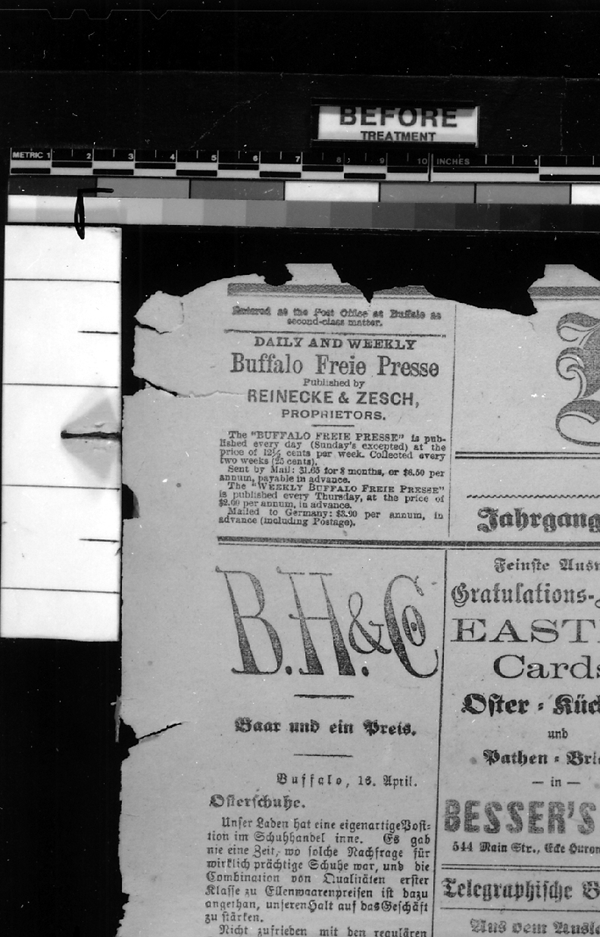 |
Fig. 18.
Newspaper page after strengthening by splitting at the ZFB, Leipzig, normal light view. The leaf-cast margin around the page offers physical protection.
 |
Fig. 19.
Newspaper page before treatment, transmitted light view
 |
5.2 5.2 17TH-CENTURY DOCUMENT WRITTEN IN IRON GALL INK
A fragment of a severely damaged iron gall ink manuscript dating from around 1680 was split by hand at Jena (figs. 21–26). The paper was so brittle that it could barely be handled. Individual sections were in constant danger of breaking off, and indeed a small fragment of the untreated piece broke loose during travel although the manuscript was carefully packaged. The manuscript underwent splitting without aqueous pretreatment as described in section 3.2. Losses in the manuscript were filled during the splitting treatment following the special double-spitting procedure developed by M�ller (see section 3.2). The facing papers were attached with a 30% (w/v) food-grade gelatin solution (240 bloom strength); an abaca fiber core paper was adhered with an adhesive consisting of methyl cellulose, acrylic resin emulsion and calcium carbonate as a buffering agent (the exact composition of the adhesive is now proprietary to Jena University); the facing papers were removed in a warm water bath with the aid of Corolase, a protease enzyme; and the paper underwent a final rinsing bath.
Fig. 21.
Fragmentary iron gall ink manuscript dating from ca. 1680, before treatment, raking light view
 |
The treatment successfully reunited the fragments. The appearance of the iron gall ink is well preserved after treatment, and the texture of the paper is still evident as seen in raking light illumination (see figs. 21, 22). Transmitted light illumination shows the excellent registration of the split halves after treatment. Also, the width of a long fracture in the paper was reduced during splitting—a treatment that would hardly have been possible using conventional repair methods due to the fragility of the paper (see figs. 23, 24). The paper now can be turned over without an auxiliary support. The paper thickness increased by 1.7 mil (0.043 mm). A number of pinhole losses of around 0.5 mm diameter occurred within the ink lines across the paper during treatment. One of these can be seen inside the loop of the letter “h” in fig. 26 (compare to fig. 25).
Fig. 22.
Iron gall ink manuscript after strengthening by splitting at the Thuringian University and State Library, Jena, raking light view
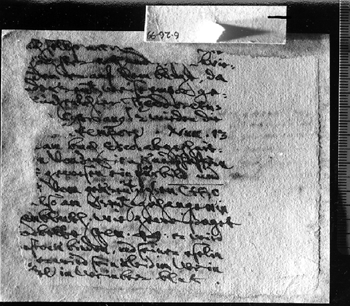 |
Fig. 23.
Iron gall ink manuscript before treatment, transmitted light view
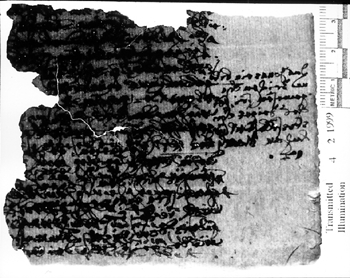 |
Fig. 24.
Iron gall ink manuscript after strengthening by splitting at the Thuringian University and State Library, transmitted light view
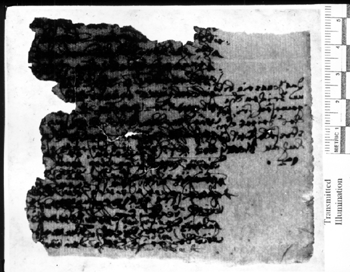 |
Fig. 25.
Detail, iron gall ink manuscript before treatment. Ruler divisions are 1 mm. Sand granules can be seen on the ink lines.
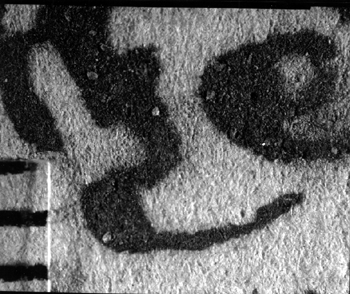 |
5.3 5.3 17TH-CENTURY BOOK LEAVES
A 17th-century book (Johann Baptist Casalio Romano, De profanis et sacris veteribus ritibus, Rome, 1644) was so severely damaged by mold that the pages could hardly be turned without incurring losses. The book was disbound, and the leaves were washed by the authors in deionized water baths conditioned with calcium hydroxide to pH 7.5 and 8. The leaves were split by hand at the ZFB using the materials described in section 3.3 (figs. 27–34): they were faced using a 30% (w/v) gelatin solution (220 bloom strength) and received a cotton fiber tissue (12g/m2) adhered with a core adhesive consisting of methyl cellulose, carboxymethyl cellulose, calcium carbonate, less than 1% acrylic resin, and the fungicide Captan. The facing papers were released in a warm water bath with the aid of Corolase, a protease enzyme, and the paper underwent a final rinsing bath.
Fig. 27.
Pages from a 17th-century book, normal light view. Left: detail of a mold-damaged page before treatment. Right: detail of a mold-damaged page after leaf-casting and strengthening by splitting at the ZFB, Leipzig. A narrow leafcast margin protects the bottom edge of the page.
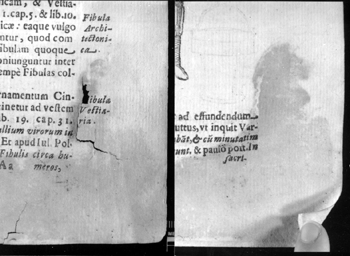 |
Fig. 34.
Book leaf, contact print of beta-radiograph of watermark made after strengthening by splitting at the ZFB, Leipzig. Radiation exposure, film and print developing were kept consistent before (see fig. 33) and after treatment. The addition of the core tissue explains the increased image density and slight diminution of contrast in the radiograph contact print.
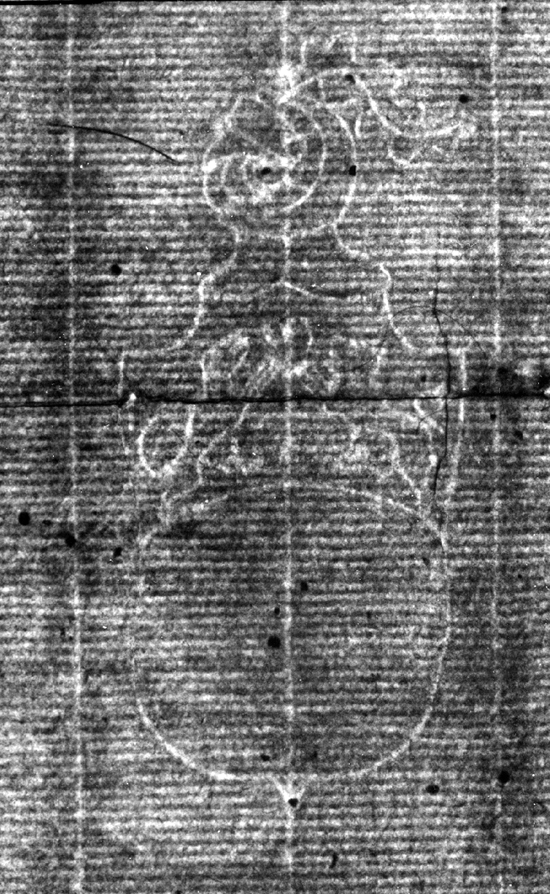 |
Five leaves had photographs and thickness measurements taken. Watermarks were documented with beta-radiography by the authors. The paper showed an average thickness increase of 1 mil (0.025 mm). The thickness of the 300-page book block increased by ca. 5/16 in. (0.8 cm) or 17%. The mold-damaged areas regained their original flexibility without feeling stiff (see fig. 27). The appearance of the paper in transmitted light remains unaltered, except where Japanese paper tissues were added to secure particularly weak areas during the splitting process (see figs. 28, 29). The surface texture of the paper was diminished during the process—a loss that one must anticipate and that will be acceptable for certain types of paper artifacts; as expected, the plate marks of the intaglio prints were flattened (see fig. 30). Some of the intaglio-printed pages were not split but repaired individually by the authors to demonstrate that the separate treatment of selected sheets within a given book is also a treatment option. The printed design on the recto and verso of one leaf shows the same alignment after treatment (see fig. 31). Small flaws in the splitting process can occur (see fig. 32). Beta-radiographs of watermarks taken before and after treatment under the same exposure and development conditions show that watermarks can still be documented after papers have been strengthened by splitting, provided they are perfectly aligned (see figs. 33, 34).
Fig. 28.
Book folio before treatment, transmitted light view
 |
Fig. 29.
Book folio after strengthening by splitting, transmitted light view. Losses have received pulp fills on the leaf-caster, and some paper areas were internally reinforced during splitting with a Japanese paper.
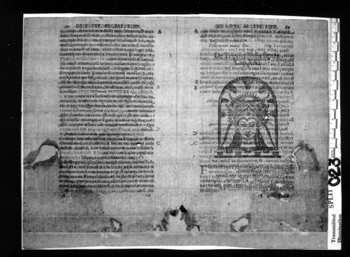 |
Fig. 31.
Detail of a book page with number “5” printed on recto and verso, seen in transmitted light. Ruler divisions are 1 mm. Left: before treatment. Right: after strengthening by splitting at the ZFB, Leipzig
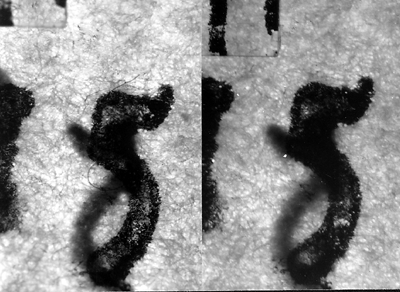 |
Fig. 33.
Book leaf, contact print of beta-radiograph of watermark made before treatment. The blurred areas are caused by the distortion of the paper.
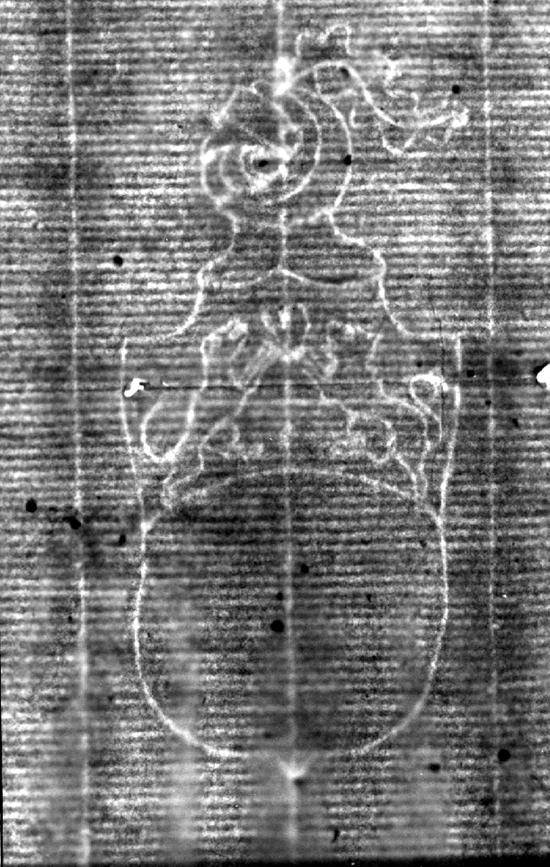 |
|













